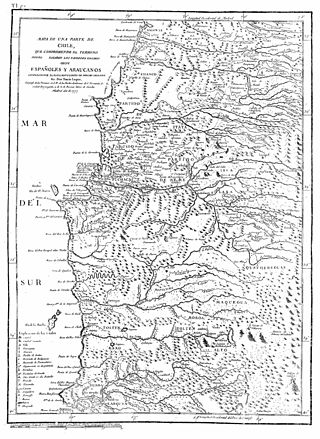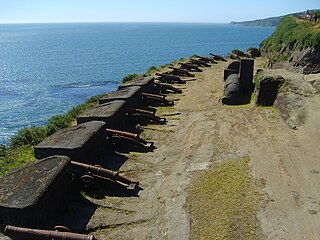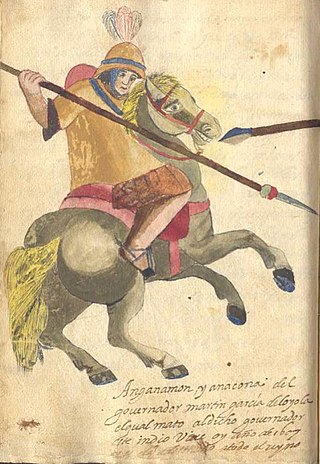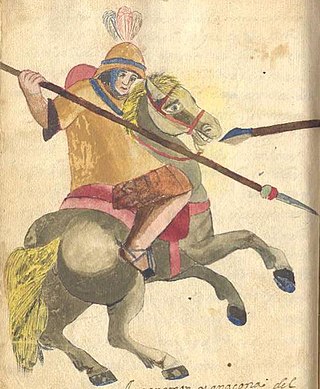
The Mapuche are a group of indigenous inhabitants of south-central Chile and southwestern Argentina, including parts of Patagonia. The collective term refers to a wide-ranging ethnicity composed of various groups who share a common social, religious, and economic structure, as well as a common linguistic heritage as Mapudungun speakers. Their homelands once extended from Choapa Valley to the Chiloé Archipelago and later spread eastward to Puelmapu, a land comprising part of the Argentine pampa and Patagonia. Today the collective group makes up over 80% of the indigenous peoples in Chile and about 9% of the total Chilean population. The Mapuche are concentrated in the Araucanía region. Many have migrated from rural areas to the cities of Santiago and Buenos Aires for economic opportunities, more than 92% of the Mapuches are from Chile.

The Arauco War was a long-running conflict between colonial Spaniards and the Mapuche people, mostly fought in the Araucanía region of Chile. The conflict began at first as a reaction to the Spanish conquerors attempting to establish cities and force Mapuches into servitude. It subsequently evolved over time into phases comprising drawn-out sieges, slave-hunting expeditions, pillaging raids, punitive expeditions, and renewed Spanish attempts to secure lost territories. Abduction of women and war rape was common on both sides.

This is a timeline of Chilean history, comprising important legal and territorial changes and political events in Chile and its predecessor states. To read about the background to these events, see History of Chile. See also the list of governors and presidents of Chile.

Alonso de Ribera y Zambrano was a Spanish soldier and twice Spanish royal governor of Chile.

The Fort System of Valdivia is a series of Spanish colonial fortifications at Corral Bay, Valdivia and Cruces River established to protect the city of Valdivia, in southern Chile. During the period of Spanish rule (1645–1820), it was one of the biggest systems of fortification in the Americas. It was also a major supply source for Spanish ships that crossed the Strait of Magellan.

Pelantaro or Pelantarú was one of the vice toquis of Paillamachu, the toqui or military leader of the Mapuche people during the Mapuche uprising in 1598. Pelantaro and his lieutenants Anganamon and Guaiquimilla were credited with the death of the second Spanish Governor of Chile, Martín García Óñez de Loyola, during the Battle of Curalaba on December 21, 1598.

The Destruction of the Seven Cities is a term used in Chilean historiography to refer to the destruction or abandonment of seven major Spanish outposts in southern Chile around 1600, caused by the Mapuche and Huilliche uprising of 1598. The Destruction of the Seven Cities, in traditional historiography, marks the end of the Conquest period and the beginning of the proper colonial period.
Cuncos, Juncos or Cunches is a poorly known subgroup of Huilliche people native to coastal areas of southern Chile and the nearby inland. Mostly a historic term, Cuncos are chiefly known for their long-running conflict with the Spanish during the colonial era of Chilean history.

Guerra a muerte is a term coined by Benjamín Vicuña Mackenna and used in Chilean historiography to describe the irregular, no-quarter warfare that broke out in 1819 during the Chilean War of Independence.

In Chilean historiography, Colonial Chile is the period from 1600 to 1810, beginning with the Destruction of the Seven Cities and ending with the onset of the Chilean War of Independence. During this time, the Chilean heartland was ruled by Captaincy General of Chile. The period was characterized by a lengthy conflict between Spaniards and native Mapuches known as the Arauco War. Colonial society was divided in distinct groups including Peninsulars, Criollos, Mestizos, Indians and Black people.

Anganamón, also known as Ancanamon or Ancanamun, was a prominent war leader of the Mapuche during the late sixteenth and early seventeenth centuries and a Toqui from. Anganamón was known for his tactical innovation of mounting his infantry to keep up with his cavalry.
Mañil or Magnil was a Mapuche lonko who fought in the 1851 Chilean Revolution and led an uprising in 1859. He was the main chief of the Arribanos and the father of Quilapán who led Mapuche forces in the Occupation of Araucanía.
As an archaeological culture, the Mapuche people of southern Chile and Argentina have a long history which dates back to 600–500 BC. The Mapuche society underwent great transformations after Spanish contact in the mid–16th century. These changes included the adoption of Old World crops and animals and the onset of a rich Spanish–Mapuche trade in La Frontera and Valdivia. Despite these contacts Mapuche were never completely subjugated by the Spanish Empire. Between the 18th and 19th century Mapuche culture and people spread eastwards into the Pampas and the Patagonian plains. This vast new territory allowed Mapuche groups to control a substantial part of the salt and cattle trade in the Southern Cone.

The Dutch expedition to Valdivia was a naval expedition, commanded by Hendrik Brouwer, sent by the Dutch Republic in 1643 to establish a base of operations and a trading post on the southern coast of Chile. With Spain and the Dutch Republic at war, the Dutch wished to take over the ruins of the abandoned Spanish city of Valdivia. The expedition sacked the Spanish settlements of Carelmapu and Castro in the Chiloé Archipelago before sailing to Valdivia, having the initial support of the local natives. The Dutch arrived in Valdivia on 24 August 1643 and named the colony Brouwershaven after Brouwer, who had died several weeks earlier. The short-lived colony was abandoned on 28 October 1643. Nevertheless, the occupation caused great alarm among Spanish authorities. The Spanish resettled Valdivia and began the construction of an extensive network of fortifications in 1645 to prevent a similar intrusion. Although contemporaries considered the possibility of a new incursion, the expedition was the last one undertaken by the Dutch on the west coast of the Americas.
In Colonial times the Spanish Empire diverted significant resources to fortify the Chilean coast as consequence of Dutch and English raids. The Spanish attempts to block the entrance of foreign ships to the eastern Pacific proved fruitless due to the failure to settle the Strait of Magellan and the discovery of the Drake Passage. As result of this the Spanish settlement at Chiloé Archipelago became a centre from where the west coast of Patagonia was protected from foreign powers. In face of the international wars that involved the Spanish Empire in the second half of the 18th century the Crown was unable to directly protect peripheral colonies like Chile leading to local government and militias assuming the increased responsibilities.
The battle of Río Bueno was fought in 1654 between the Spanish Army of Arauco and indigenous Cuncos and Huilliches of Fütawillimapu in southern Chile. The battle took place against a background of a long-running enmity between the Cuncos and Spanish, dating back to the destruction of Osorno in 1603. More immediate causes were the killing of Spanish shipwreck survivors and looting of the cargo by Cuncos, which led to Spanish desires for a punishment, combined with the prospects of lucrative slave raiding.
The Mapuche uprising of 1655 was a series of coordinated Mapuche attacks against Spanish settlements and forts in colonial Chile. It was the worst military crisis in Chile in decades, and contemporaries even considered the possibility of a civil war among the Spanish. The uprising marks the beginning of a ten-year period of warfare between the Spanish and the Mapuche.

Banditry was a considerable phenomenon in 19th century and early 20th century Central Chile and Araucanía. Many bandits achieved legendary status for their brutality and others for being regarded folk heroes. The bandits usually preyed on haciendas and their inquilinos.
The Huilliche uprising of 1792 was an indigenous uprising against the Spanish penetration into Futahuillimapu, territory in southern Chile that had been de facto free of Spanish rule since 1602. The first part of the conflict was a series of Huilliche attacks on Spanish settlers and the mission in the frontier next to Bueno River. Following this a militia in charge of Tomás de Figueroa departed from Valdivia ravaging Huilliche territory in a quest to subdue anti-Spanish elements in Futahuillimapu.

Among the indigenous Mapuche people of Chile, there are those that practice traditional polygamy. In modern Chile polygamy has no legal recognition. This puts women whose marriages to their husbands are not legally recognized at a disadvantage in relation to the legal wife who is, in terms of securing inheritance. Polygamy is much less common today in comparison with the time preceding the Occupation of Araucanía (1861–1883), when the traditional Mapuche homeland was brought under control of the Chilean government. It survives as a chiefly rural practice, but has also been reported in the low-income peripheral communities of Santiago. Wives who share the same husband are often relatives, such as sisters, who live in the same community. According to hearsay, polyandry among the Mapuche is reputed to exist at least historically, in which case the husbands may have been brothers, but no documentation exists attesting to this phenomenon. It is also in contradiction to the renewal of the warrior ethos (weichan) promoted by militant Mapuche organizations such as Coordinadora Arauco-Malleco.











